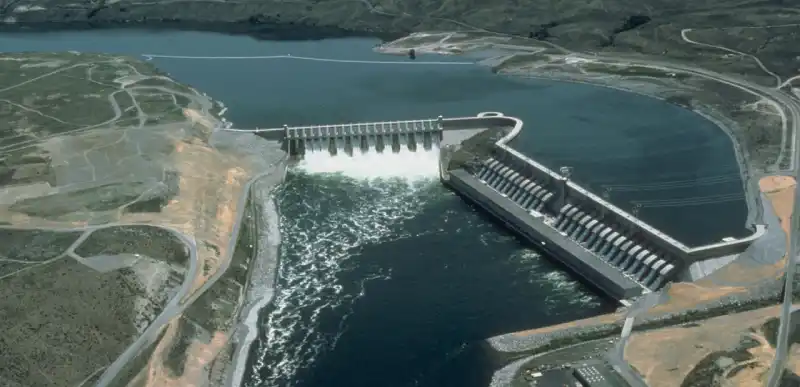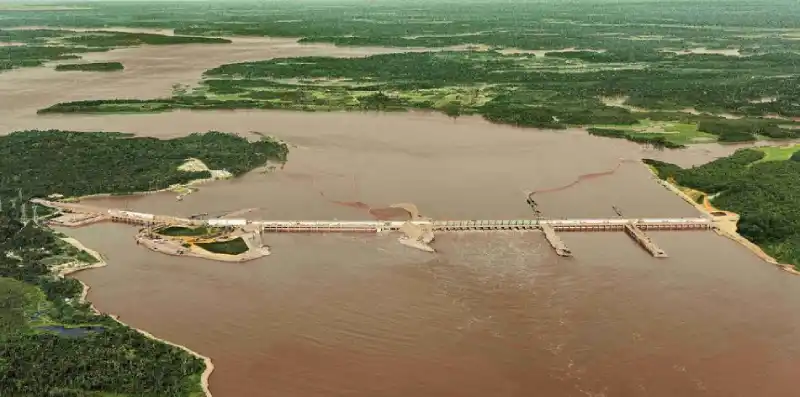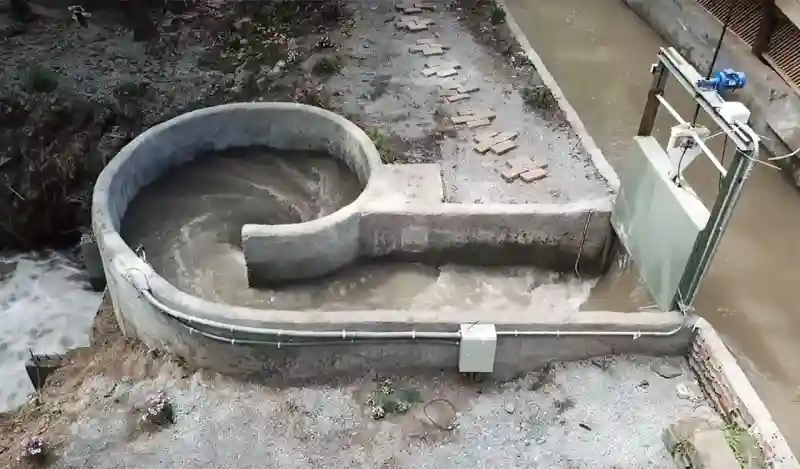Alternative hydro: Run-of-the-river schemes
Hydro is often synonymous with gargantuan projects, evoking images of structures like the Hoover or Three Gorges Dam. It’s seen as colossal green power generation at the expense of widespread flooding and its consequences.
But there are techniques to harness a river’s energy without altering its course fully, which have become collectively known as Run-of-the-river (ROR) hydropower.
This article introduces you to this more respectful version of using water as an energy source. Let’s dive in!
Contents
- What is run-of-the-river hydro?
- It’s not a new technology at all!
- What are the pros and cons of run-of-the-river hydro?
- How does run-of-the-river work?
- Making Hydro Lean but Mean
- External Resources
What is run-of-the-river hydro?

While traditional hydropower involves damming a river to create a reservoir, run-of-the-river (ROR) hydro takes on a less intrusive role.
Instead of damming gargantuan volumes of water to store gravitational energy, these schemes aim to fit more carefully within a natural river system by diverting part of the water flow into a generator, or creating a permeable dam that swells a section of the river, causing it to pass over turbines.
Instead of subduing nature to the ‘will of men’, the run-of-the-river harnesses the river’s natural flow to generate electricity for as long as the river keeps flowing.
ROR reduces the swelling effect upriver and produces consistent baseload power as it relies on the river flow and not the fully controlled filling and release of reservoir hydroelectric. The resulting capacity factors are arguably the highest of any energy source, as water flow in many rivers is perpetual with mild seasonal variations.
What we found surprising is that ROR has been in use for a long time but is recently re-gaining traction as demand for low-carbon energy increases, together with the progressive view that the less we affect nature, the more it will come back to benefit us.
That being said, massive hydro schemes have fallen out of favour, and small-scale projects like run-of-the-river are making a comeback, and rightly so.
But will it really take off? Especially given the urgency with which we need to expand our low-carbon energy capacities.
It’s not a new technology at all!

The use of moving water to drive a mechanical system is certainly not a novelty, dating at least as far back as the ancient Greeks, who used it to grind cereals like wheat into their respective flours.
The British were the first to use moving water to produce electricity during the Industrial Revolution, and this technology rapidly caught on across the globe.
In Massachusetts (US), the Lowell Power Canal System, operational since the late 19th century, has been using run-of-the-river principles within a canal system for power generation and goods transportation.
Nowadays, there are thousands of run-of-the-river schemes all across the world, ranging from tiny kW-rated schemes to feed the small requirements of rural communities, all the way to the 3,580 MW-rated Santo Antonio scheme in Brazil.
What are the pros and cons of run-of-the-river hydro?
Generally speaking (as each project is unique!), these are the pros and cons of ROR:
Advantages
- It’s both a low-carbon and a renewable energy source, the same as regular hydro.
- It has a lower environmental impact than regular hydro because the flood area is smaller, and the flow of the river is not fully interrupted, only managed.
- Fish that spawn upriver can still do so through the implementation of fish ladders or safe turbines.
- Having smaller dams than regular hydro, the capital costs may be smaller.
- It can achieve similarly high levels of efficiency as hydro, with Kaplan turbines reaching up to 95% efficiency.
- It can be scaled down to micro-generators or up to GW-rated projects.
- ROR schemes are highly compatible with systems of locks that, through river swelling, can extend the navigable portion of rivers (e.g. Columbia and Madeira rivers).
Disadvantages
- Relies on a river with a reliable flow rate in order to function, with climate change (drought) posing a long-term threat.
- It cannot store energy like regular hydro or PSH, as the dam cannot contain the entire river flow of the river.
- Large projects still require large capital and time investments, and their socio-environmental impact can be significant in certain cases (e.g. Brazil).
- A grid connection may require long-distance transmission as eligible rivers may be located away from load/population centres.
- Thermal pollution and increased water turbidity may be an inevitable outcome if badly designed.
These will rapidly become evident in the run-of-the-river examples below
How does run-of-the-river work?
The thinking behind implementing ROR is always very similar. You choose a river that has a reliable water flow, and you either divert some of its flow to run parallel to the main river or you build a permeable dam (i.e. a weir) to simply manipulate the water volume into an orderly flow that can power a turbine effectively, without fully damming the river.
In any case, there are a number of projects and concepts that may be worth introducing here, so let’s look at some examples of run-of-the-river projects around the world to see what kind of designs have been implemented and at what scales:
Rio Madeira ROR system, Brazil (The largest)

As a major tributary of the Amazon River, the mighty Rio Madeira carries an immense volume of water, a potential powerhouse for electricity generation that remained untapped until the early 2000s.
Realizing the opportunity, the Brazilian government decided to harness this force of nature but wanted to avoid the environmental mistakes associated with traditional, massive hydro schemes.
The Rio Madeira project consists of two independent power generators, the Santo Antônio Dam and the Jirau Dam (under construction), boasting capacities of 3,580 MW and 3,750 MW, respectively.
Rather than colossal blockades against nature, these structures are more penetrable, more like weirs than impenetrable walls. They integrate turbines within their design and contain spillways to channel any excess water, avoiding structural damage safely.
The Santo Antônio Dam has been operational since 2012. With its fifty turbines, each rated at 70 MW, it holds the title of the largest run-of-the-river project in the world. For context, were it located in the UK, it would overshadow all power stations except the mammoth Drax Power Station.
Both dams sit in the deep Amazon, one of the most environmentally sensitive regions of the world. Yet, they have escaped significant environmental backlash, primarily because, as ROR schemes, they do not entail extensive flooding of the surrounding rainforest.
For instance, the strategically designed Santo Antônio dam only swells the river upstream by 65% of its original area. Contrastingly, conventional dammed hydropower projects can cause valley-wide inundations, expanding the water-covered area by more than 10,000% of the original river footprint.
Despite stretching a whopping 3 km to span the river’s width, the Santo Antônio Dam incorporates eco-friendly features like a fish ladder for migratory species and a shipping lock to allow boats to traverse this tributary to the Amazon River.
Interestingly, these shipping locks could potentially become a geopolitical game-changer in the region. Being a land-locked country upstream, Bolivia might gain access to the Atlantic Ocean if the river becomes fully navigable due to the combination of ROR and shipping locks. This could open a new chapter for Bolivian maritime trade.
However, delivering the electricity generated by these remote dams to Brazil’s main load centres on the South-Eastern coast requires a high-voltage transmission system. This transmission line has set a world record, stretching an impressive 2,300 km, more than twice the length of the UK!
However, the schemes are not without controversy. Implementing infrastructure in such remote areas often comes with unexpected social impacts. As pointed out in this documentary, the introduction of these projects has been linked to an increase in crime, prostitution, and drug-related issues.
Moreover, the fluctuating water levels caused by the dams have contributed to a surge in malaria cases and heightened the flood risk for local communities with little state protection. We think this is not a matter of ROR but a matter of building large infrastructure in lawless places like remote Brazil.
Columbia River ROR system (US) – Allowing a navigable system
The Columbia River in the United States might very well be the river with the most hydropower capacity installed along its path – an impressive 36 GW. To put that into context, this capacity is sufficient to satisfy three-quarters of the peak winter power demand in the UK.
The river is home to 14 dams, of which 4 are run-of-the-river schemes. These include the Chief Joseph Dam (2,620 MW), Dalles Dam (1,878 MW), John Day Dam (2,160 MW) and the Bonneville Dam (1,242 MW).
The establishment of these run-of-the-river schemes can be traced back to as early as the 1930s Great Depression. At that time, the environmental consequences of infrastructure projects were hardly a primary concern; the focus was primarily on economic recovery. What’s intriguing is that the preference for ROR over traditional hydro wasn’t driven by upfront capital costs or environmental motivations but rather by the desire to maintain the Columbia River as a navigable channel.
The low height of run-of-the-river dams allows for the construction of locks and weirs, facilitating navigation. By strategically placing a series of these less intrusive dams across the river system, the river can be swelled sufficiently to allow passage for larger ships, all while generating electricity. The low dam height makes it feasible to build fish ladders, enabling the migration of spawning fish upstream.
Turbulent Hydro – Micro Run-of-the-River

Taking a break from discussing specific projects, let’s look into a unique run-of-the-river concept instead. Developed by the Belgian company Turbulent, this micro-ROR concept piqued our interest due to its elegant simplicity and striking visual appeal. The setup is essentially ‘set-and-forget’, requires minimal space and maintenance, and can be installed relatively quickly
The smaller models only need a height difference of 1.5 meters to operate. A canal is dug adjacent to the water flow, equipped with a single electronically-controlled sluice gate to manage the water flow. This canal guides the water into a whirlpool basin, where the water spirals downward towards a turbine at the centre – reminiscent of water swirling down when flushing a toilet.
Inspired by Kaplan turbines typical of large-scale run-of-the-river hydro, the water reaches the turbines in a rotational pattern, boosting energy efficiency. This snail-shaped structure fits snugly within the system, allowing any confused fish to pass safely through the turbine thanks to the blades’ spacing and relatively slow rotation. The water then rejoins the normal river flow.
Turbulent is geared toward off-grid rural areas, making it an elegant solution for off-grid businesses and distributed grids. And we can’t see any reason besides traditional regulation as to why this couldn’t be implemented within urban areas with canal systems, like many towns in the UK that still heavily rely on natural gas.
The Turbulent team have already installed small 5kW systems in France, Estonia, Indonesia, Chile, and Portugal. They’re set to install larger schemes in Taiwan (100kW), the Philippines (140kW), Thailand, the DRC, and even Norfolk (UK). In Norfolk, the energy generated will be used to power the Environment Agency’s own EV chargers!
Of course, these projects don’t compare with larger run-of-the-river schemes in terms of sheer output, but having another micro-renewable alternative to micro-wind, bladeless wind, and solar power is still very promising to help power the millions in rural areas who are still disconnected to the grid.
Making Hydro Lean but Mean
Run-of-the-river hydro is NOT a mutually exclusive alternative to traditional hydropower, but one that can work in conjunction with other hydropower technologies, including traditional hydro, Pumped Storage Hydro (PSH) or micro-generators.
Perhaps you want to generate some electricity with minimal environmental impact to preserve sensitive environments? Build a series of 100% run-of-the-river schemes in the area to harness key places without extensive disruption.
Need to generate enormous amounts of energy to power energy-hungry industries? Construct a major run-of-the-river schene à la Madeira or Columbia River that generates GW-rated power while extending the navigable sections of the river at a minimal environmental cost (at least, considering its huge magnitude!).
You’ve built up a vast intermittent renewable capacity via wind and solar power but lacking storage? Design closed-loop Pumped Storage Hydro (PSH) storage systems that use the excess renewable energy to recharge.
Or, if you desire all three (scalability, low impact to sensitive areas, and energy storage), implement all these concepts within a valley simultaneously. Run-of-the-river can be seen as another tool in the renewables’ arsenal to reach net zero by 2050 without having to build another Three Gorges Dam
Or, if you’re a small business in the UK with a small stream running through your property, you could use renewable business energy to reduce commercial electricity rates.
External Resources
- Turbulent Hydro
- Rio Madeira HDVC
- Jirau Dam – Enerdata
- Jirau e San Antonio: relatos de uma guerra amazonica
- Kaplan Turbines
- ROR Hydro Example
- SAE Renewables – ROR Hydro in Scotland
- Energy Education
- Alberta Univesity

